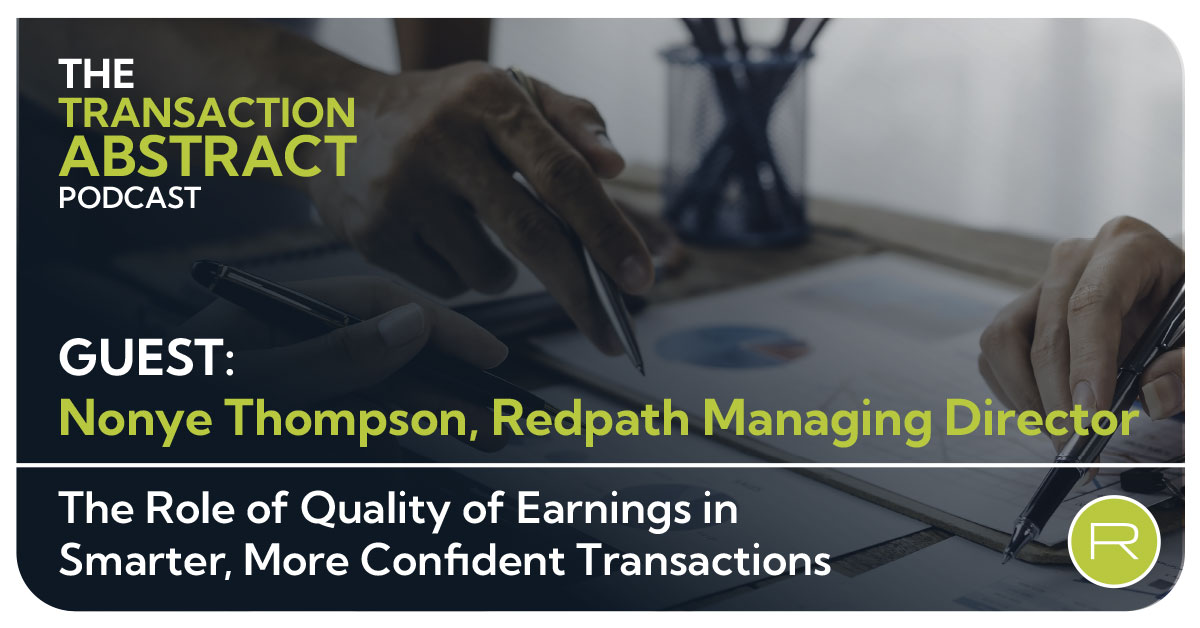The Role of Quality of Earnings in Smarter, More Confident Transactions
In this episode of The Transaction Abstract Podcast, Joe Hellman sits down with Nonye Thompson, Managing Director in Redpath’s Transaction Advisory...
4 min read
 Redpath and Company
:
Aug 19, 2021
Redpath and Company
:
Aug 19, 2021
![IOIs, LOIs, and the Homestretch of a Business Transaction [PODCAST]](https://www.redpathcpas.com/hubfs/two%20colleagues%20reviewing%20business%20performance%20charts%20on%20a%20tablet%20and%20laptop.jpg)
Once you have begun receiving interest from buyers, you might feel like you are in the homestretch of your business transaction. In actuality, confirming the terms of a buyer's interest – or the interest of multiple buyers – is one of the more nuanced stages of a transaction, characterized by complex decision-making, interpretation, and competitive tension.
Following a discussion of the first two phases of a sell-side transaction (Marketing Phases 1 and 2), we invited Jared Rance, Managing Director of Hennepin Partners back to The Transaction Abstract for an in-depth look at these crucial elements of the later stages of a business transaction. Read and listen for inside information on the various pieces of dealing with interested parties and how to leverage them to your advantage when selling your business.
Listen to this conversation on The Transaction Abstract, a podcast from Redpath:
Two documents form the basis of this late stage of a business transaction: the Indication of Interest (IOI) and the Letter of Intent (LOI). As their names would indicate, these two documents denote different levels of buyer readiness, but they are both cornerstones of finding the right buyer in the transaction process.
At the most basic level, an IOI is a document that comes from buyers to let you know they are willing to pay for your company. But that definition comes with a lot of caveats.
By the time an IOI comes into play, both parties have already been through the first two marketing phases of a transaction. That means an interested buyer has seen limited information about the business (possibly including a 'teaser document' with basic quality of earnings information), they have had limited interactions with the seller's transaction advisory team, and they may not have ever met with the seller themselves in a broad process.
While it is far from the last step, the terms in an IOI should be seen as foundational to the LOI that will follow. In pre-LOI diligence, your transaction advisor can make available a draft purchase agreement they can mark up or a term sheet that outlines what Jared calls "deal killers" for interested parties, like deal structure and key definitions to outline in the eventual purchase agreement.
The information in an IOI, as well as a buyer's motivation for sending it, "really comes down to [the buyer's] view of value," Jared says. Think of an IOI as a notification that an interested party has taken a basic look under the hood of your business and is interested in pursuing a deal further.
Compared to an IOI, an LOI can be seen as a sign the party is more serious about buying your business. In M&A context, an LOI is "a more firm view of a buyer's interest in a company, and it goes beyond just value," Jared says. By the time a buyer sends an LOI, a lot has likely transpired – facility tours, meetings, management presentations to qualify interest.
The LOI shows that a buyer has done the legwork, often including early diligence, and includes information like their price, terms, timing, remaining diligence, plans for management teams, financing, closing conditions, approvals, and more. The LOI can also solidify the terms laid out in a draft purchase agreement or term sheet your advisor provided earlier in the process.
Unless stated in the terms of the letter, an LOI isn't considered legally binding. In a competitive M&A process, sellers should view each LOI as the buyer's proving ground where they get to differentiate themselves from the rest of the candidates. "It's really meant at trying to determine who is the ultimate best buyer for a business," Jared says. "You've wanted to force people to do as much diligence as possible and give you as much certainty and clarity around what their interest looks like."
You may get one LOI or several at once – so should you accept the one with the biggest number and move toward a close? While time is of the essence in most transactions, Jared warns against reactive moves when the LOIs start coming in. "Just because the sheet of paper says 'letter of intent' in the subject line doesn't necessarily mean that it's what we would consider a true letter of intent," he says.
"How much diligence do they have left, and how long will it take them to close a transaction? And then what is the nature of their remaining diligence or their approval process, and how certain do we think they are as a buyer to getting to an outcome?"
When you get multiple letters, you and your transaction advisor can use the factors of each buyer's letter to increase competitive tension on the others to create an optimal outcome. Maybe Buyer A's closing timeline is further off, but they want to retain your management team – unlike Buyer B, whose value is higher. Or maybe Buyer X's LOI has a lower value offer than Buyer Y's, but Buyer X can close well within your timeframe.
In a competitive transaction process, leveraging each factor of an LOI against your priorities as a seller is incredibly important: As soon as a seller accepts an LOI, leverage moves from the seller to the buyer because the buyer now has an expectation of exclusivity. That can make the buyer feel like they have freedom to alter terms or provisions not made concrete in the LOI. That is what makes an experienced advisory team so important in the homestretch of a deal.
"We think about properly structuring the letter of intent and those exclusivity provisions," Jared says. "To allow flexibility such that if a buyer changes terms and conditions, or they don't hit timelines or milestones, that they're not allowed to drag out the process just because they've got that protection of exclusivity."
The stage at which you begin considering LOIs is "a key place where making sure you've got sort of that right cast of advisers around the table," Jared says. "Both your investment banker or financial adviser, as well as versed legal counsel that is attuned to the M&A market and knows how to put all of those protections in place as we get into this stage of the process."

In this episode of The Transaction Abstract Podcast, Joe Hellman sits down with Nonye Thompson, Managing Director in Redpath’s Transaction Advisory...

In this episode of The Transaction Abstract Podcast, Joe Hellman sits down with Dan Hennessey, the newly appointed CEO of Sam Schwartz Pedestrian...
![Common Legal Pitfalls in M&A Transactions with Kim Lowe [PODCAST]](https://www.redpathcpas.com/hubfs/Podcast-Legal-Pitfalls-Kim-Lowe.jpg)
In this episode of The Transaction Abstract Podcast, Joe Hellman sits down with Kim Lowe, Partner at Avisen Legal, to discuss the most common legal...